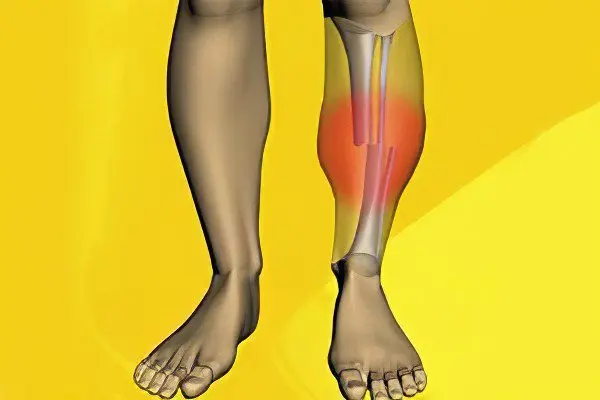Contents

Fracture of the tibia – this is a violation of its integrity, sometimes complete, and sometimes partial, which occurs if the load exceeds the strength of the bone tissue. Usually, the injury is the result of a blow to the leg, which may be the result of an unsuccessful jump, a fall from a height, a car accident, careless movement along the street in the winter season, or extreme sports.
The tibia is often injured, due to the peculiarity of its location and the absence of a tissue layer. Often, the fibula next to it also breaks. The risk of getting this kind of damage increases in people over the age of sixty, which is associated with the peculiarities of the structure of their bone tissue. It becomes more brittle and porous, so even not too strong a blow can lead to a fracture. Small children are also susceptible to injury due to their high physical activity. They often have fractures of this tubular bone without displacements and sharp fragments.
Types of fractures of the tibia
In traumatology, fractures of the tibia are usually classified as follows:
Fracture, which is the formation of a small crack, which can be located vertically and horizontally;
Comminuted fracture, when bone fragments form during an injury;
Closed fracture, when the broken tibia does not break through the soft tissue;
An open fracture, in which the integrity of the skin is violated, and the bone communicates with the external environment;
A stress fracture, which is a characteristic injury to the tibia. It is formed as a result of traumatic overstrain, when the bones already had small cracks. Often this kind of damage is received by professional athletes, for example, gymnasts or basketball players.
Symptoms of a fracture of the tibia
Knowing the main symptoms that are characteristic of this injury, you can independently identify it and seek medical help in time:
The pain syndrome has its own characteristics. At a time when the leg is at rest, the pain of the victim is aching and dull. When a person makes an attempt to lean on a limb, then the pain becomes sharp;
Edema and hematoma form around the fracture site. They appear most often immediately after injury;
The leg itself looks deformed, there may be unnatural mobility of the bone in the area of the fracture;
Violation of the sensitivity of the foot rarely worries. Sometimes it becomes pale and cold, which indicates serious damage to blood vessels and nerves.
In the case of a person receiving an open injury, there is no doubt about its nature. A gaping wound will be visible, the bone will come out, bleeding will open.
First aid for a fracture of the tibia

If a person has received a similar injury, then competently provided first aid will be the key to a speedy recovery.
Before the arrival of the team of doctors, or before sending the victim to traumatology, it is important to carry out the following activities:
Try to relieve the pain. For this, any remedy at hand is suitable: Ketorol, Analgin, Ibuprofen, Nimesulide;
The injured limb must be immobilized by splinting. Even ordinary boards are suitable for this. One of them is attached to the inside of the leg, and the other to the outside. After the tire is fixed with a bandage or tissue bandage. It is important to immobilize the entire limb, with particular attention to the knee and ankle joint;
If the fracture is open, then all visible contamination should be removed, and the edges of the wound should be treated with an antiseptic solution, and then covered with a sterile bandage;
When there is heavy bleeding, a tourniquet should be applied to stop it. A suitable place for this is the thigh.
Diagnosis of a fracture of the tibia
Upon admission of the victim to a medical institution, the doctor will perform the following actions, which will be aimed at clarifying the diagnosis:
Perform a visual examination for the presence of a violation of the integrity of the skin, edema, hemorrhage, displacement and other signs of a fracture;
Conduct an oral survey to clarify the circumstances of the incident and have a more accurate idea of the nature of the damage;
Uses methods of instrumental examination: X-ray and, possibly, computed tomography. CT is more often ordered when there is a suspicion of a fracture of adjacent joints.
These measures will help clarify the diagnosis and prescribe treatment.
Treatment of fractures of the tibia

The therapeutic focus will depend on the nature of the injury and its severity.
It will be possible to do without surgery under the following circumstances:
If the fracture is closed and the displacement is minimal;
If the patient is unable to undergo surgery;
If before that a person already had limited mobility, and the difference in the length of a healthy and injured leg observed after a fracture is not critical.
In order for the patient to feel more comfortable with severe edema, the doctor may apply a splint. It can be tightened and relaxed. After that, a plaster cast must be applied. The period of wearing it is determined by the doctor, most often, the fusion of the tibia takes from 4 to 6 weeks.
Surgical treatment is indicated when:
There is an open injury;
The fracture is unstable, fragments are strongly displaced;
Conservative measures proved ineffective.
The most commonly used in practice method of treating trauma to the tibia is intraosseous osteosynthesis. Its essence lies in the introduction of a metal pin inside the medullary canal, which crosses the fracture zone, fixing the fragments in place.
An older method of treatment is the fixation of fragments with plates and screws. It is used when osteosynthesis is not possible. Before these constructions are installed, fragment reposition will be required.
For recovery procedures include visiting a massage parlor, performing exercise therapy and observing a diet. With adequate treatment with modern methods and the patient’s fulfillment of all the recommendations of the doctor, the restoration of limb functions occurs as soon as possible.










წვივის ძვლის მოტეხილობის ოპერაციიდან რამდენი დღის შემდეგ შეიძლება ფეხის დადგმა ?